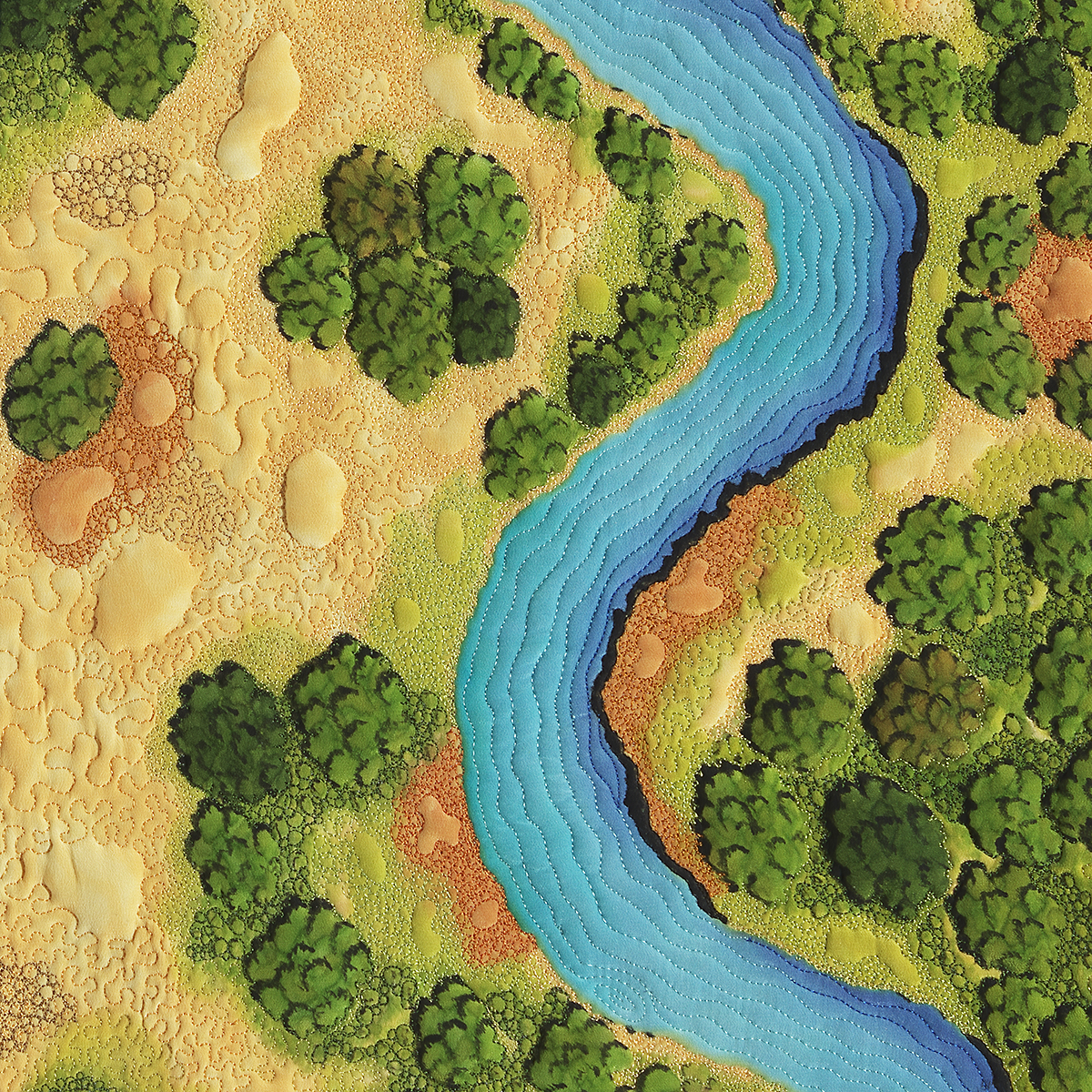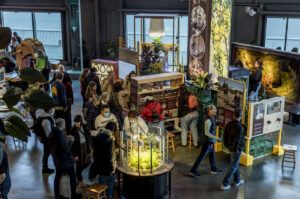Artwork by Linda Gass is included in Under Water, on view at the Palo Alto Art Center from January 21 through April 8, 2023.
If you’re like most people and have never thought about textiles and maps at the same time, together, then you just might be the target audience for artist Linda Gass. Add climate change, land use, and Bay Area waterways into the mix, and it’s safe to say her work is unlike anything else out there. “When people see photographs of my work,” she acknowledges, “they don’t know what it is at all.”
A great example of Gass’s art is Urban Power vs. San Lorenzo Creek—What’s Next? The triptych of three tall and thin quilts illustrates the changing nature of the East Bay’s San Lorenzo Creek over time. Using historic maps, aerial photographs, and contemporary satellite maps, Gass depicted a segment of the creek and the land bordering it as they were in 1873, in 1946, and today. The land transforms from a willow-speckled grassland to a mostly agricultural site and then to a completely suburbanized landscape. But most striking is the changing shape of the creek; over nearly 150 years we see it narrow and straighten considerably, until it is finally corralled by concrete. It has been tamed, as if its presence was a threat to urban development. The present-day panel has the sensuous puffy texture common in many of Gass’s quilts, and she has not depicted the suburbs as a dystopia or an abomination. All three expertly crafted silk quilts are in fact beautiful. Nonetheless, merely placing these landscapes side by side creates a critique that’s self-evident: development is destroying the creek.
For Gass, exquisite textiles are bestowed with political power. “I use beauty to lure people in,” she explains. “Textiles are this really accessible medium. It’s something that we live with in our everyday lives. From the moment we’re born, we’re wrapped in textiles and we wear them every day. We sleep in them; they’re all around us in our homes, and then when we die, we’re wrapped in them.” This comfort and accessibility, she argues, offers viewers an entry point to think about big, complex environmental issues.
Gass is a self-described map lover, and she borrows from maps and aerial imagery without, strictly speaking, making maps themselves. Despite this love, she feels conflicted about maps, noting that “the Western history of mapmaking is all about resources for humans and ownership—colonialist sentiments.” But maps are powerful tools, she adds—they are succinct and efficient in describing land—and so Gass doesn’t dismiss the form altogether. Rather, she borrows from the language of maps, utilizing descriptive efficiency while also highlighting relationships with and within given landscapes. For her, the appeal of beauty and subtlety holds these elements together and invites her audiences in for a conversation.
Often colorful and vibrant, Gass’s art revels in the colors of Bay Area grasslands and wetlands. In contrast, her large piece Severely Burned (2014), recently a part of the Palo Alto Art Center’s Fire Transforms exhibition, stands out: nearly six feet wide, the artwork captures the 2014 Rim Fire’s impact on the Tuolumne River watershed. Against a stark black background, Gass uses white stitching to map out areas designated as severely burned by the U.S. Forest Service. She likewise stitched the region’s topographic lines, “using the rationale that now that the vegetation is completely burned, the topography is clearly visible.” Blue stitching represents the waterways, highlighting the entanglement of the burn area and the watershed. This is a picture of tragic absence, and Gass calls it a “ghost-like image.”
But this artwork too can be regarded as beautiful, with its dramatic contrasts and intricate stitching. Its allure carries that invitational quality Gass regards so highly, yet when it brings you in, you must confront the destructiveness of fire, drought, and climate change. And this can be emotionally difficult. How can destruction have visual appeal? Gass recalls a man who loved the work when he saw it in her studio. After she told him about its context he replied, “I really wish you hadn’t told me that, because I thought it was so beautiful.” The story made him want to turn away. But the artwork beckons us regardless.
Artwork by Linda Gass is included in Under Water, on view at the Palo Alto Art Center from January 21 through April 8, 2023.



